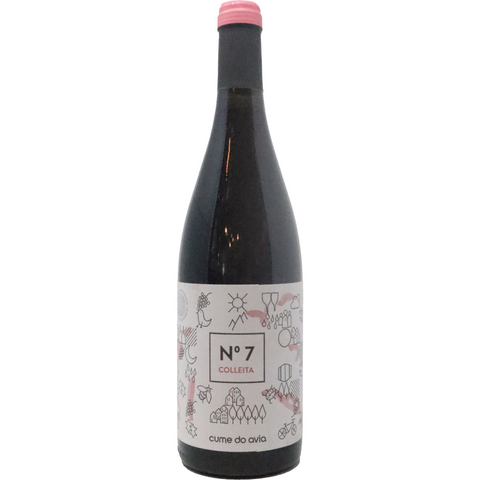
2019 Cume Do Avia "No7" Colleita Tinto, Galicia, Spain
This is an elegant display or bright red fruit along with some nice minerality of wet stone Its ethereal presence is matched nicely with its rustic, earthy undertones.
ABOUT THIS WINE
All the grapes are co-fermented together naturally with 40% whole cluster for three weeks in restored ancient chestnut foudre. Extraction is made in the “infusion style” with gentle pushdowns of the cap by hand to keep it moist and extract as little as possible. Malolactic fermentation is completed in this wine–noted because many of the reds in Cume do Avia’s range do not.
It is aged for five months in 50+hl ancient chestnut foudre. No fining but it a light filtration.
Raw and enticingly naked, the Colleita Tinto is the charming starting block for Cume do Avia’s range of honest and hardly touched wines, made from a blend of indigenous red Galician varietals. Caino Longo (40%) and Brancellao (26%) bring elegance and taut red fruits, and the balance from Sousón (34%), the dark, agile beast with a deep, vigorous acidity. It’s angular but still soft and restrained, and drinks as much like a white as it does red, save its glorious, dainty and fluttery red wine characteristics and the influence of its three-week fermentation with more than a third from whole bunches.
As in all of Cume do Avia’s range, Colleita 7 checks the boxes of a true vin de terroir. A shade over 12% alcohol, it’s aged in an ancient, restored chestnut barrels, and is replete with mineral and metallic impressions derived from the acidic soil mixture of metal heavy granite, schist and slate.
ABOUT THIS PRODUCER
A real wine family business from the region Eira dos Mouros, Galicia, which is led by the brothers Diego and Alvaro Collarte and their cousins Fito y Anxo. Everything takes place in Ribadavia, (Ribeiro) where the proximity of their land to the Atlantic, the south and west-facing orientation maximize the sun’s heat in an otherwise cold region. The richness of the diverse soils, and the constant whistle of fierce winds that bring in the fresh air and help grapes to stay dry and pest free. It’s an ideal place within this green landscape for their organic and biodynamic practices. Souson, Brancellao, Merenzao, Treixadura, Lado, Caiño Blanco, among many others are the varieties used to craft the beautiful wines.
The Ribeiro is better known for white wine, and while Cume do Avia has really stepped up their game in that department, it’s the reds that bring a greater thrill of discovery. The revelation when tasting them is in how they manage to be angular and vertical while remaining strong and somehow full on all sides of the palate. They all carry a decisive full frontal attack, weighted mid-palate and a long, textured mineral sharp finish. Many wines grown solely on granite tend to front-load in the palate, leaving the mid and back-palates behind in their potency; regions like France’s Northern Rhône Valley, Corsica and Muscadet often demonstrate this characteristic.
Schist and slate seemingly weight the scales in the opposite direction as granite and drill deep into the mid and back-palate, making the combination of these soil types within one wine extremely complex and on par with limestone terroirs that seem to carry a fuller mouthfeel in general by comparison to granite, slate and schist as single bedrock terroirs. The result is wines that manage to be both concentrated and lithe at the same time. They rest on the palate like a mouthful of small steel weights rather than with a dough-like density.
There are no fertilizers or soil amendments in the vineyards, which keeps the wines as true and pure as possible, and prevents them from being overly vigorous and unnecessarily weighted. They’re low alcohol, high acidity wines with energy like rays of sunlight through the clouds on a fresh, wet spring morning, rather than sweltering summer heat under a cloudless desert sky.
Details:
| Grape(s) | Caiño Longo, Sousón, Brancellao |
| Farming | Organic |
